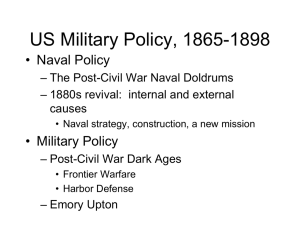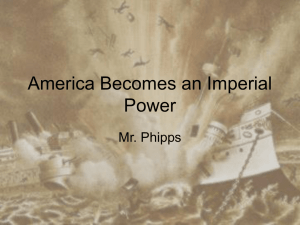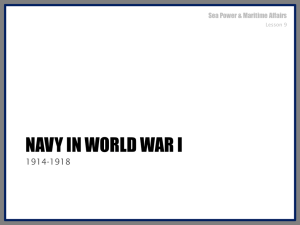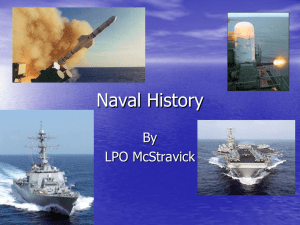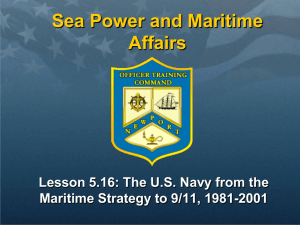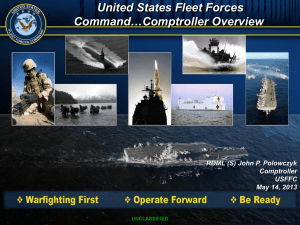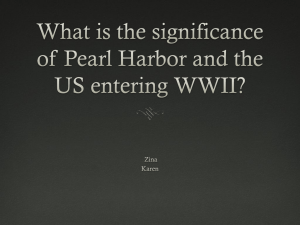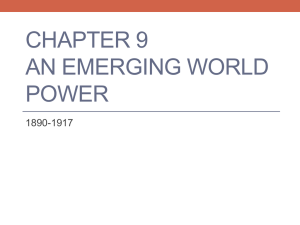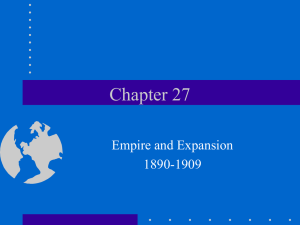The US Navy and American Imperialism
advertisement
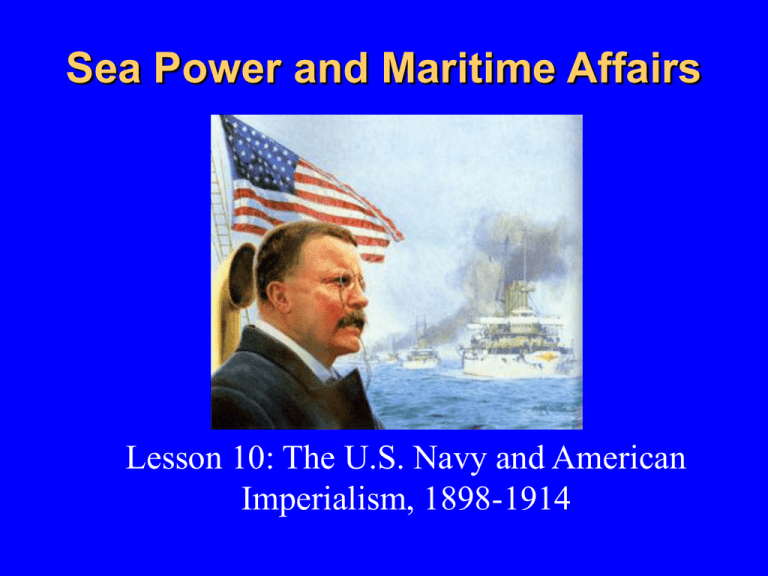
Sea Power and Maritime Affairs Lesson 10: The U.S. Navy and American Imperialism, 1898-1914 Learning Objectives Know the influence of the mass media in U.S. relations with Spain and the effect of the destruction of the USS Maine on public opinion. Comprehend the impact of Mahanian Doctrine on the naval strategy and thinking in preparation for and conduct of the war. Comprehend the reasons for the acceleration of U.S. Navy expansion following the war with Spain. Learning Objectives Know the effect of the Progressive Era in domestic politics on the Navy. Comprehend the threats and resultant actions taken by the U.S. concerning activities in the Pacific and Caribbean during the period 1900-1914. The Spanish-American War “a splendid little war” Causes Decreased isolationism in U.S. public and Congress Cuban Revolution (1895-1898): – – – U.S. investments threatened Spanish authorities commit atrocities against Cuban civilians Sympathetic to Cubans The Catalyst USS Maine Explosion - February 1898: – – – Havana, Cuba. Mission — protect U.S. citizens and property. U.S. public angered - blame placed on Spain. “Free Cuba!” “Remember the Maine!” President William McKinley – Congress declares war on Spain -- April 1898. USS Maine Havana, Cuba February 1898 Fighting the War Geography – Spanish Empire- Cuba, Puerto Rico, Philippines, Guam – U.S. strategic interests Panama Canal, Hawaii U.S forces – Atlantic: Sampson/Schley – Asiatic: Dewey (China/Japan) Fighting the War Geography – Spanish Empire- Cuba, Puerto Rico, Philippines, Guam – U.S. strategic interests Panama Canal, Hawaii U.S forces – Atlantic: Sampson/Schley – Asiatic: Dewey (China/Japan) President William McKinley Naval Orders of Battle United States – North Atlantic Squadron – Sampson based in Key West. Schley’s “Flying Squadron” in Norfolk. USS Oregon sent from Pacific to Atlantic. Asiatic Squadron Commanded by Commodore George Dewey at Hong Kong. – Sent by Assistant Secretary of the Navy Theodore Roosevelt. Spain – Inferior naval forces. Montojo - Manila Bay Cervera - Cape Verde Islands Fighting the War Cuba – Blockade of Santiago harbor (1 May) – Amphibious landing at Daiquiri (June 20) – Destruction of Cevera’s Fleet (July 3) Sampson/Schley command controversy Naval Results Battle of Santiago American blockade of Santiago Harbor. – Amphibious landing at Daiquiri. – Leads charge at the Battle of San Juan Hill. Spanish governor orders fleet to flee harbor - 1 July 1898. – Confusion between Army and Navy: Shafter and Sampson. Rough Riders’ Teddy Roosevelt. – Guantanamo Bay seized by Huntington’s battalion of Marines. Sampson / Schley command controversy. Results and lessons: – Spanish home fleet recalled while en route to the Philippines – U.S. technological superiority overwhelms Spanish. – U.S. becomes dominant power in the Caribbean Sea. – Improvement needed in fire control and amphibious doctrine. The “Rough Riders” Battle of San Juan Hill 1 July 1898 Teddy Roosevelt “Far better is it to dare mighty things, to win glorious triumphs, even though checkered by failure... than to rank with those poor spirits who neither enjoy nor suffer much, because they live in a gray twilight that knows not victory nor defeat.” Rough Riders USS Oregon Battle of Santiago Commodore George Dewey Commander U.S. Asiatic Squadron Spanish-American War Battle of Manila Bay 1 May 1898 U.S. Asiatic Fleet sails from Hong Kong to Manila. – Dewey orders increased training and gunnery practice. Spanish use shore guns to augment anchored fleet. Dewey: “You may fire when you are ready, Gridley.” – – Spanish fleet sunk at anchor. Superior American gunnery. Dewey becomes a national hero. Siege of Manila follows with Army troops. War against Aguinaldo's Philippine Nationalists. – Philippine Insurrection or Filipino-American War- 1899-1902. – U.S. establishes control of entire Philippine Archipelago. Battle of Manila Bay Battle of Manila Bay “You may fire when ready, Gridley.” - Commodore George Dewey Battle of Manila Bay 1 May 1898 Commodore George Dewey Battle of Manila Bay Battle of Manila Bay Dewey’s Flagship U.S. “Empire” Established From Spain in 1898: – Puerto Rico – Guam – Philippines – Guantanamo Bay Naval Base in Cuba (Spain sells other island territories in the Pacific to the German Empire in 1899.) Formerly Independent: – Hawaii (Annexed 1898) – Wake Island - 1899 – “American” Samoa (Harbor of Pago Pago) - 1899 American Pacific Territories Coaling Stations for Ships U.S. Navy after the War Battleships principle warship Mahan's advocacy of fleet engagements vindicated. – Commerce raiding discredited. Construction programs to be completed by 1905: – 10 first-rate battleships. – 4 armored cruisers. Global empire yields: – – Overseas bases. Expanded obligations to protect overseas interests. Dewey heads new Navy General Board. – – First U.S. peacetime strategic planning apparatus. Missions are to devise war plans and assess foreign navies’ capabilities. Progressive Era Politics (1901-1914) Strong Presidents: – Theodore Roosevelt, William Howard Taft, and Woodrow Wilson. Republican Congress funds battleships and canal construction. – Large increases in federal budget. – Large increase in percentage of federal budget for Department of the Navy. Dewey and General Board – Access to Secretary of the Navy and / or the President on a regular basis due to increased importance of the Navy. Prewar International Concerns 1900-1914 Expanding Interests of Germany, U.S. attention to Caribbean Expanding Interests of Japan, U.S. attention in Pacific “The Big Stick” Theodore Roosevelt (December 1904): – U.S. obligated “in flagrant cases of wrong-doing or impotence (in Latin America) to the exercise of an international police power.” Constant interventions by Navy and Marines: – Haiti, Nicaragua, and the Dominican Republic. – Cuba - Platt Amendment. – Vera Cruz, Mexico. “Yankee Imperialism” despised by many Latin Americans. Panama Canal Renewed U.S. desire for canal in Central America. – Link between Atlantic and Pacific Fleets. Need for the canal is highlighted by USS Oregon’s long transit to the Battle of Santiago. Strong support from President Theodore Roosevelt. – Essentially Mahanian Panama Canal Panamanian Revolution against Colombia - 1903. – – Construction of the canal begins in 1904. – Engineered and influenced by U.S. Panama Canal Zone ceded to U.S. Completed in 1914. Increased importance of U.S. control of Caribbean Sea. – Protection of Panama Canal is vital to defense of the U.S. U.S. Interests in the Far East War Plan Orange – – U.S. Navy plan for war with Japan. Defense of the Philippines and defeat of the Japanese Navy. The Open Door U.S. “Open Door” policy in China: – – Policy has two aspects. (1) Ensure territorial integrity of China. (2) Ensure free trade in China for all countries. China’s Boxer Rebellion - 1900 – U.S. Marine Regiment attached to U.S. Army force protecting Westerners. Counter European and Japanese attempts at “spheres of influence”. Yangtze River Patrol - U.S. gunboats protect American commerce. The Rise of Japanese Sea Power Opening and Modernization Commodore M.C. Perry - 1854 – Treaty of Kanagawa – European powers quickly follow U.S. lead. Meiji Restoration - 1868 – – End of Tokugawa Shogunate’s feudal system. Emperor restored to power. Increased trade with the West. Rapid modernization of industry and armed forces. Colonial expansion begins on Pacific Islands. Japanese Navy – From the Age of Galleys directly to the Modern Age. – Skips entirely the Age of Sail. Russian Warships THE JAPANESE NAVY Japanese Battleship Mikasa Japanese Battleship Asahi Japanese Battleship Shikishima Japanese Armored Cruiser Yakuma Increases in U.S. Naval Power By 1898 – 4 1st Class Battleships: Indiana, Massachusetts, Oregon, and Iowa. – 2 2nd Class Battleships: Texas and Maine. – 2 Armored Cruisers. – 10 Protected Cruisers. – Gunboats, Monitors, Torpedo Boats. Modern technology in the fleet: – Steam, armor, and rifled breech-loading guns. President Theodore Roosevelt and Rear Admiral Robley D. “Fighting Bob” Evans Prior to the sailing of the Great White Fleet 1907. The Great White Fleet Route of the Great White Fleet – 1907-08 Technology Improvements Improved gunnery: – Smokeless powder. HMS Dreadnought - 1907 – First all “big-gun” battleship launched by Great Britain. – Makes all other battleships obsolete. Battle Cruisers – Same armament as dreadnoughts but less armor. – Faster speeds. Destroyers - Vital part of fleet - protection from torpedoes. Submarines – – USS Holland - 1900 Diesel engines developed allow greater maneuverability. Radios - Improved communications. HMS Dreadnought - First all “big gun” Battleship. - Eight 12-inch guns. HMS Dreadnought Wright Brothers Kitty Hawk, North Carolina 17 December 1903 Eugene Ely USS Birmingham (CL 2) 14 November 1910 Dawn of Naval Aviation Wright Brothers -- Kitty Hawk, North Carolina: 1903 Eugene Ely – First flight of an aircraft from a ship in 1910. – First landing of an aircraft on a ship in 1911. Glenn Curtiss - First seaplane landing - 1911. Lieutenant “Spuds” Ellyson: Naval Aviator #1. Royal Navy in a similar stage of development of aviation. Dawn of Naval Aviation Birthday of Naval Aviation: 8 May 1911. – U.S. Navy purchases two Curtiss biplanes. Office of Naval Aeronautics established in 1914. Early naval aviation missions: – Scouting location of the enemy fleet. – Directing naval gunfire. Naval Aviation Then and Now 1910: Naval Aviator #1 Eugene Ely performs the first take off from a ship at sea 2007: Naval Aviator #26089 Scott Palumbo forced to teach Naval History to unwilling midshipmen Reading: - Potter: chapter 17-19 (through WWI) - Hagan: chapter 8 Research for Discussion: - “Roosevelt Corollary to the Monroe Doctrine” Tomorrow: - USMC lecture (MIDN 2/C Mallory) Midterm: - Review on Monday (study sheets) - Up to and including WWI QUESTIONS / DISCUSSION Next time: The U.S. Navy and the World at War, 1914-1918

